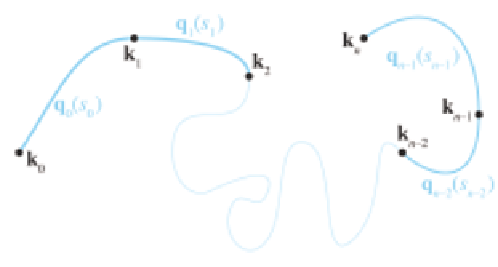Game Development Reference
In-Depth Information
Figure 13.18.
A spline with
n
segments has
n + 1
knots, named
k
0
. . . k
n
.
In animation contexts, the knots are sometimes called keys. This is
a reference to the old-school animation methods where a master animator
would create the key frames, or frames where the characters reached impor-
tant poses. The in-between frames would be filled in by a less experienced
(and less expensive) apprentice. In computer animation, a key can be any
position, orientation, or other piece of data whose value at a particular
time is specified by a human animator (or any other source). The role of
the apprentice to “fill in the missing frames” is played by the animation
program, using interpolation methods such as the ones being discussed in
this chapter. As we've noted before, most of the early research on splines
was aimed at defining static shapes, not animated trajectories, and so the
term “knot” is more prevalent.
13.7
Hermite and B ezier Splines
A spline is made by patching together curve segments so that they fit to-
gether smoothly. What sorts of curve segments? For reasons that will soon
become apparent, it is most convenient for us to use the Hermite represen-
tation for the individual segments. When we say convenient “for us,” we
mean the people writing the code for an animation system or carrying out
the mathematical discussion in the following sections. When it comes to
depicting or manipulating splines graphically, the Bezier form is typically
preferred. Of course, the Hermite and Bezier forms are closely related, and
it is easy to convert between the two forms. If you don't remember this
relationship, we review it in just a moment.









Search WWH ::

Custom Search